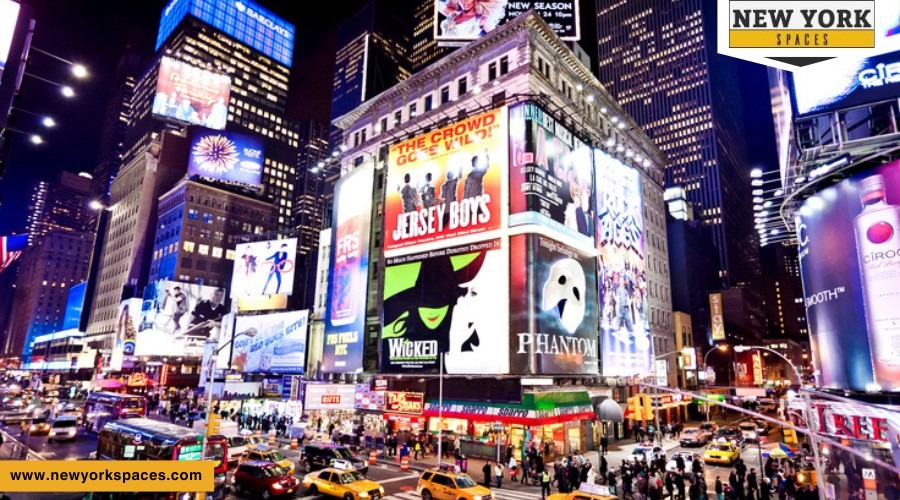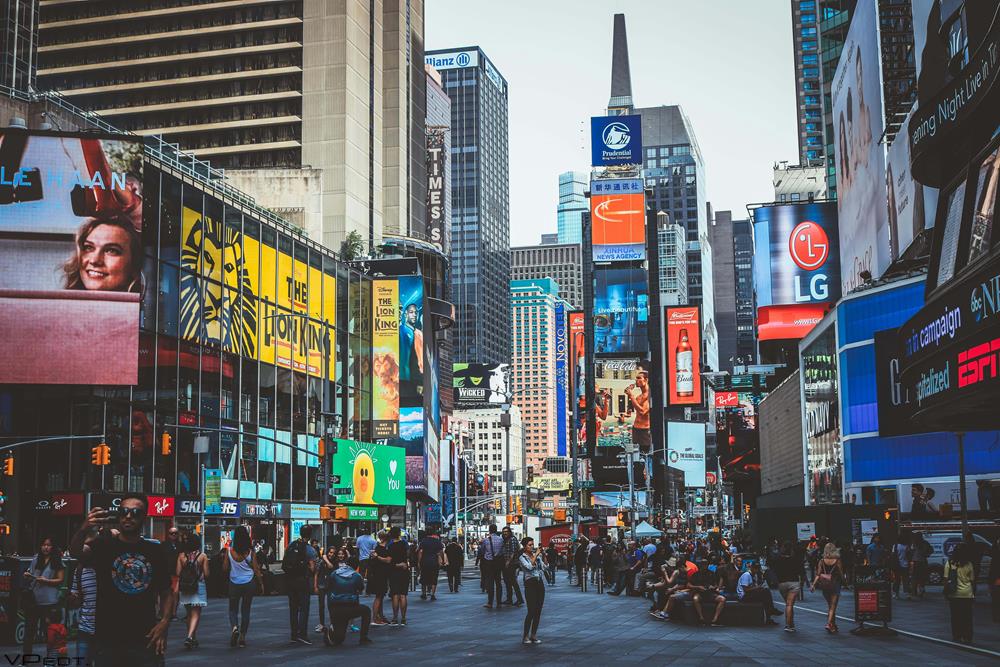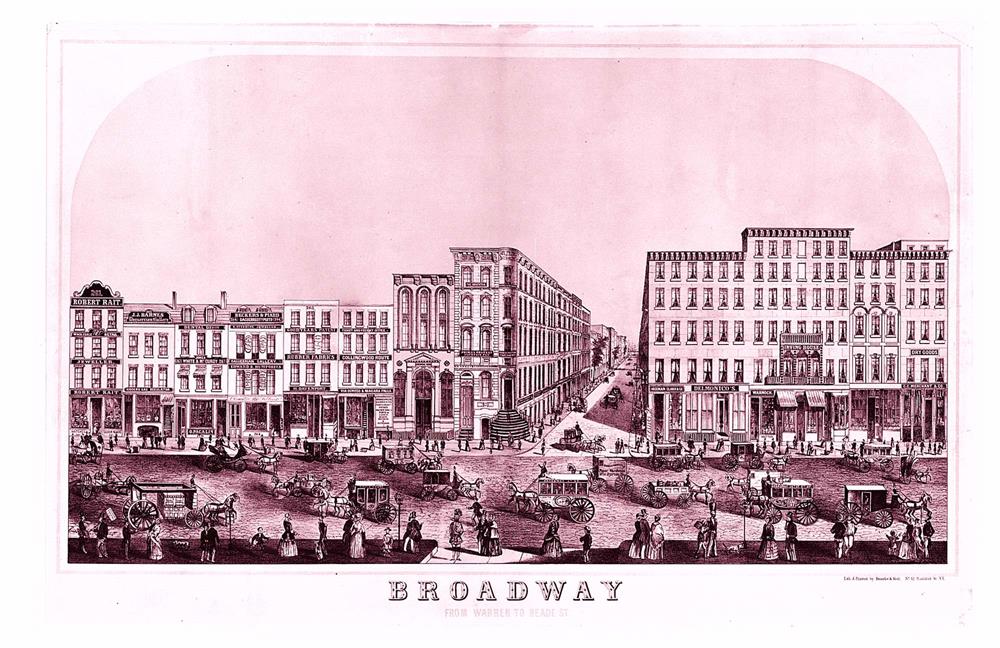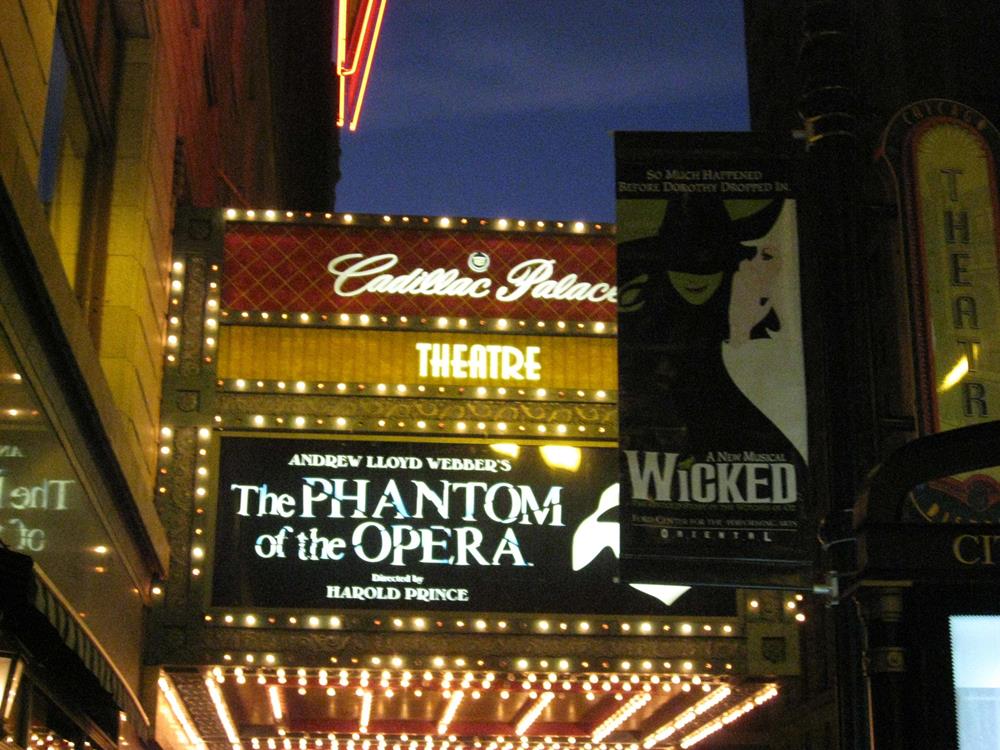Those who are familiar with New York City and its major attractions would probably have heard of Broadway. And if you’re a theater fan, it’s the place to be and a travel bucket list for those who live abroad. It’s one of the legendary streets of New York, lit by the neon marquees of legendary theaters, buzzing with anticipation. Here, stories come to life, and dreams take center stage.
If you’re preparing for your trip to The Great White Way, you’re in the right place! This guide will help you navigate through the essentials of a Broadway visit so you can soak in the exciting atmosphere of the Theatre District with ease.
What is Broadway?
Broadway, at its core, is more than just a street in New York City. This historic north-south route transforms into a cultural phenomenon as it passes through Times Square in Midtown Manhattan, an area famously known as the Broadway Theater District. The word ‘Broadway’ itself has become synonymous with this vibrant stretch of theatre and performance.
The actual geographic footprint of Broadway is surprisingly modest, especially when you consider its immense cultural impact. Encompassing the area from 42nd to 52nd Streets, most of the theatres are nestled within a block of Broadway itself. Although there are some outliers (like the Lincoln Center on 65th Street with its own Broadway theatre), picturing the Broadway Theater District as a compact rectangle in the heart of Manhattan is the easiest way to envision it.
Broadway stages are known for drawing in the world’s finest actors, singers, musicians, and dancers. Their performances in the district’s relatively intimate theatres create an extraordinary and memorable entertainment experience, one that has endured through the years.
Here are some of the main theaters you can find on Broadway – each with its own history and charm:
- The Richard Rodgers Theatre: Celebrated for being the home of the sensational musical ‘Hamilton,’ the Richard Rodgers Theatre boasts a rich history. This venue is known for its intimate ambiance and has been the stage for a multitude of famous productions since its opening in 1924.
- The Gershwin Theatre: As the largest Broadway theater, the Gershwin is a modern marvel known for hosting the long-running hit ‘Wicked.’ Its spacious seating and grand scale make it a go-to destination for blockbuster shows.
- The Majestic Theatre: A staple of Broadway, the Majestic is synonymous with ‘The Phantom of the Opera.’ Known for its classic architectural design, this theater has been mesmerizing audiences since the 1920s with its grandeur and elegance.
- The Shubert Theatre: Steeped in Broadway history, the Shubert has hosted countless legendary productions. Its iconic neon marquee and prime location make it a symbol of Broadway’s timeless allure.
- The Lyceum Theatre: As one of the oldest surviving Broadway venues, the Lyceum is noted for its smaller, more intimate setting. Its Beaux-Arts design offers a step back into a bygone era of theatrical splendor.
- The Al Hirschfeld Theatre: Celebrating the art of caricaturist Al Hirschfeld, this theater stands out with its unique Art Nouveau style. It has been a vibrant spot for musicals and plays that enjoy longer runs.
- The Palace Theatre: Originally a vaudeville house, the Palace Theatre is deeply rooted in theatrical tradition. It’s renowned for its grandiose interior and has been the stage for numerous notable performances.
- The Walter Kerr Theatre: A smaller venue known for its intimate setting, the Walter Kerr Theatre provides a close-up experience of plays and musicals. It’s a gem within the Broadway community, offering a deeply personal theater experience.
What Defines a “Broadway Show”?
Technically speaking, any performance held in a Broadway theatre is deemed a Broadway show. These theatres are characterized by their seating capacity, with a minimum of 500 seats required to be classified as a Broadway theatre (as opposed to the smaller Off-Broadway venues). New York City boasts 41 theatres that meet this criterion.
The size of Broadway theatres adds to their charm, ranging from the intimate Hayes Theatre, seating 597 people, to the expansive Gershwin Theatre, which can accommodate 1,933 patrons. This contrasts sharply with larger venues like Radio City Music Hall or Carnegie Hall, reinforcing Broadway’s unique, cozy ambiance.
Consider the phenomenon of a hit show like ‘Hamilton,’ which opened in 2015 at the Richard Rodgers Theatre with 1,319 seats. Even with eight shows a week, meeting the overwhelming demand proved a challenge, highlighting the unique draw and intimacy of Broadway productions.
A Short History of Broadway
Broadway started in the mid-18th century, around 1750, with the establishment of a resident theatre company at the Theatre on Nassau Street by actors Walter Murray and Thomas Kean. This theatre, which held about 280 people, set the stage for the future of New York theatre, showcasing Shakespeare’s plays and ballad operas.
After a hiatus during the Revolutionary War, New York’s theatre scene was revived in 1798 with the opening of the 2,000-seat Park Theatre on Chatham Street, now Park Row. The early 19th century saw the emergence of significant theatres like the Bowery Theatre in 1826 and others, expanding the city’s theatrical landscape.
In 1829, P.T. Barnum’s entertainment complex and Niblo’s Garden at Broadway and Prince Street opened and became one of New York’s premier nightspots. The Astor Opera House, which opened in 1847, was central to the infamous Astor Place Riot of 1849, reflecting the class divisions in theatre audiences at the time. Renowned Shakespearean actors like Edwin Booth graced the stage, with Booth performing a famous 100 consecutive shows as Hamlet at the Winter Garden Theatre in 1865.
In the 19th century, theatre gradually moved from Downtown to Midtown Manhattan, with Oscar Hammerstein I building the Victoria Theater on West 42nd Street in 1895. The Black Crook considered the first modern musical, debuted in 1866, and by the late 19th century, the heart of Broadway was near Union Square, eventually moving to Times Square in the early 1900s.
The early 20th century saw the rise of major playwrights and the installation of electric signs outside theatres, earning Broadway the nickname “The Great White Way.” The actors’ strike in 1919 led to the standardization of contracts, with the Shubert Brothers eventually dominating the theatre scene.
During the late 1960s and 1970s, Broadway experienced a decline partly due to the rise of motion pictures. However, due to the efforts of theatrical producer Joe Papp and many others, the Theatre District was preserved, and Broadway was bustling again by the early 1980s.
The COVID-19 pandemic led to an unprecedented shutdown of Broadway theatres in March 2020. The pandemic brought about significant changes, including delayed shows, the introduction of vaccination requirements, and a push for greater diversity in theatre representation, with theatres being renamed to honor Black theatrical personalities.
Guide to Your First Broadway Visit
Now that you’re acquainted with Broadway’s history and theaters, here’s a guide to help you navigate Broadway!
Choosing the Right Show
When it comes to Broadway, the sheer variety of shows on offer can be both exhilarating and overwhelming. Choosing a good one is key to ensuring your first Broadway experience is as enchanting as the lights on Times Square. Here’s how to navigate the sparkling array of options.
Consider your interests and preferences
Broadway caters to an astonishing range of tastes. From heart-wrenching dramas and toe-tapping musicals to family-friendly performances and thought-provoking plays, there’s something for everyone. Reflect on what moves you. Are you looking for a night of laughter, a deep dive into dramatic storytelling, or a visual spectacle of dance and music? Your personal preferences are your best guide.
Check reviews and recommendations
In the digital age, opinions are never far away. Look up reviews from reputable sources like The New York Times or Variety for professional insights. Don’t underestimate the power of word-of-mouth, either. Ask friends or family who are theatre enthusiasts for their recommendations. Sometimes, a show might not have blockbuster appeal but could resonate deeply on a personal level.
Consider star power and cast
Broadway often features stellar casts, including renowned actors from stage and screen. If there’s a performer you admire, catching them live can be a once-in-a-lifetime experience. However, remember that Broadway is also a platform where new talents emerge. Sometimes, going in without preconceived notions about the cast can lead to the most delightful surprises.
Find information on current shows
Today, staying updated on current and upcoming shows is easier than ever. Official Broadway websites, social media channels, and theatre apps provide comprehensive information. They not only list shows but also offer snippets, cast details, and run times. Don’t forget to check out digital lotteries and discount apps – they sometimes offer great deals, especially for those willing to make spontaneous plans.
Buying Tickets
The thrill of deciding to see a Broadway show is only the beginning. Next comes the pivotal task of purchasing tickets, a step that can be as strategic as it is exciting. Whether you’re planning months ahead or looking for a spontaneous theatre adventure, understanding the ticketing process can make all the difference.
Timing is key
The golden rule of Broadway ticketing is that timing matters. Booking in advance is always advisable, especially for popular shows that can sell out weeks, or even months, ahead. Early birds often get the best seat selections and, sometimes, better prices. However, if you’re flexible with dates and shows, last-minute tickets can also be a fantastic option, often at a fraction of the cost.
Know where to buy tickets
Official box offices and authorized retailers are the safest bets for purchasing legitimate tickets. In the age of the internet, buying tickets online has become the norm. Websites like Ticketmaster or Telecharge are popular choices. For those who prefer a more personal touch, visiting the theatre’s box office can also be a charming part of the Broadway experience. Plus, it often saves you from online booking fees.
Check out discounts and deals
Who doesn’t love a good deal? Discounted tickets are available through several channels. TKTS booths in New York offer same-day tickets at a discount, perfect for spontaneous theatre-goers. Online, you’ll find websites offering promotional codes or special discounts. For students and young adults, many shows offer rush tickets — significantly discounted tickets available on the day of the performance. And let’s not forget lottery tickets, where a bit of luck can land you a front-row seat to a hit show at a bargain.
Look for last-minute options
Sometimes, the best plans are the ones we don’t make. Several shows offer day-of tickets, either through rush policies or digital lotteries. These tickets are often substantially cheaper, though they do require a bit of flexibility and, sometimes, patience. If you’re open to surprises and don’t mind the uncertainty, these options can add an extra thrill to your Broadway adventure.
Preparing for the Show
Your tickets are in hand, the date is circled on your calendar, and the excitement is building. Now, it’s time to prepare for the actual event. Broadway shows are not just performances; they are experiences. To fully enjoy this immersive adventure, a few preparations are in order.
Dress code
Broadway doesn’t enforce a strict dress code, but it’s an opportunity to dress up and immerse yourself in the glamour of the theatre world. While you’ll see a range of attire, from casual to cocktail dresses and suits, the key is to opt for something comfortable yet stylish. Whether it’s a neat pair of jeans and a smart top or a lovely evening gown, wear something that makes the night feel special. Remember, theatres can be heavily air-conditioned, so carrying a light sweater or jacket is wise.
Arrival times
Arriving early is a part of the Broadway ritual. Aim to be there at least 30 minutes before the curtain rises. This buffer allows you to find your seat, browse the program, and absorb the unique ambiance of the theatre. Plus, it’s a chance to visit the restroom and settle in without rushing. Latecomers may face delayed entry as many shows have specific policies about seating late arrivals, often not until a suitable break in the performance.
If you’re late, ushers will typically assist you in entering at an appropriate time. Be prepared to wait until a designated break in the performance, which could mean missing the opening scenes. Similarly, if you need to leave the auditorium during the show, re-entry is usually allowed, but again, ushers will guide you on when to re-enter.
Follow theatre policies
Broadway theatres have policies to ensure an enjoyable experience for everyone. One key rule is about mobile devices – they must be turned off or set to silent mode. Not only do ringing phones disrupt the performance, but using phones during the show is generally frowned upon. It’s about respect for the performers and your fellow audience members. Additionally, photography and recording during the performance are strictly prohibited to preserve the integrity and magic of the show.
Broadway Theatre Etiquette
Attending a Broadway show is more than just a cultural experience – it’s participating in a tradition of respect and appreciation for the performing arts. As you prepare to immerse yourself in the magic of Broadway, understanding basic theatre etiquette will enhance your experience and show respect to both the performers and fellow audience members.
Give them an applause
Applause is the primary way audiences express their enjoyment and appreciation during a Broadway show. It’s customary to applaud after musical numbers and at the end of each act. The final curtain call is an important moment, where enthusiastic applause and standing ovations are common ways to show your appreciation for the performance. Remember, the energy and response of the audience can greatly contribute to the atmosphere of the show.
Respect the performers
While the excitement of seeing renowned actors up close can be thrilling, it’s essential to maintain a respectful demeanor. Avoid shouting out or trying to talk to the performers during the show. Such actions can be distracting and disruptive. The magic of Broadway lies in the boundary between audience and performers – a space where storytelling takes the lead.
Stay silent
During the performance, it’s important to stay as quiet as possible. Avoid whispering or talking, as it can distract those around you and the actors on stage. Also, unwrapping candy or loudly rustling programs should be avoided for the same reasons. Part of the joy of theatre is losing yourself in the story unfolding before you, a joy best experienced in a quiet, attentive environment.
Turn off or silence your electronics
As mentioned earlier, turning off or silencing mobile phones and electronic devices is non-negotiable. The light from screens can be distracting, and the sound can disrupt the immersive experience Broadway aims to provide. Take this time to disconnect from the digital world and savor the live performance in front of you.
Respect fellow audience members
Finally, always be considerate of those around you. This includes maintaining personal space, minimizing movement during the performance, and being patient when exiting the theatre. Everyone is there to enjoy the show, and mutual respect goes a long way in ensuring a pleasant experience for all.
Interludes
Intermissions are an integral part of the Broadway experience, offering a brief respite between the acts. These pauses are not just functional breaks but also opportunities to reflect on the performance, socialize, and prepare for the continuation of the theatrical journey. Here’s how to make the most of these interludes.
Duration and timing
Typically, intermissions on Broadway last about 15 to 20 minutes. This brief period is designed to allow the audience to stretch their legs, use the restroom, or grab a quick refreshment. Keep an eye on the time as intermissions pass quickly, and the theatre will dim the lights or sound a bell to signal the end of the break.
Restrooms and refreshments
Intermissions are notoriously known for restroom queues. If you need to use the facilities, it’s wise to head there immediately. So, before you go, it’s better to empty your bladder!
Many theatres also offer refreshments, ranging from drinks to light snacks. These can be enjoyed in the lobby or theatre areas designated for eating and drinking. Remember, theaters generally do not allow bringing food or drinks back into the seating area.
Discussing the show
Intermissions offer a perfect moment to discuss the performance with your companions. It’s fascinating to hear different perspectives on the story, characters, and performances. These conversations can enrich your experience, allowing you to return to the second act with a deeper connection to the narrative.
Reviewing the program
The intermission can also be a good time to look through the show’s program. These often contain interesting details about the cast, the creative team, and the production itself. Understanding the background and effort that goes into a Broadway show can heighten your appreciation for the performance.
Preparation for the second act
As the intermission nears its end, it’s time to return to your seat. Take a moment to refocus and prepare for the continuation of the story. The second act often builds upon the foundation laid in the first, leading to climactic moments and resolutions.
Exploring the Theatre District
The Great White Way isn’t just the heart of Broadway; it’s a vibrant center of dining, culture, and exploration. Enhance your Broadway experience by also checking this out on your visit:
Dining Recommendations:
- Sardi’s: An iconic New York eatery famous for its celebrity caricatures on the walls. Sardi’s is a traditional choice for a pre-theatre dinner, offering classic American cuisine.
- Joe Allen Restaurant: Popular among theatre-goers and actors alike, this spot is known for its casual American fare in a relaxed setting, perfect for post-show discussions.
- Carmine’s Italian Restaurant: Ideal for groups, Carmine’s serves Italian classics in family-style portions, creating a communal and festive dining experience.
- The Lambs Club: For a more upscale experience, this club offers a luxurious setting with a menu crafted by Chef Geoffrey Zakarian, making it a great choice for a special night out.
Cultural Hotspots:
- Times Square: A must-visit for its bustling atmosphere and iconic imagery. The electric energy here is a quintessential New York experience.
- New York Public Library for the Performing Arts: Offers fascinating exhibitions on the history and art of theatre. It’s a great place to delve deeper into the cultural context of Broadway.
- Duffy Square’s Red Steps: These steps are not just a great photo opportunity; they are a place to sit and watch the vibrant energy of the city. They also overlook the TKTS booth, where you can grab last-minute show tickets.
Broadway Memorabilia:
- The Drama Book Shop: A treasure trove for theatre lovers, this shop offers a wide selection of scripts, books on theatre, and unique Broadway gifts.
- One Shubert Alley: Known as the official Broadway store, it’s the perfect place for show posters, cast recordings, and souvenirs from your favorite productions.
Side Streets:
Take a walk down side streets like 46th Street, known as “Restaurant Row,” for its diverse range of dining options, or explore the historic Shubert Alley, a famous pedestrian alley known for its theatre history.
Helpful Tips for Broadway First-Timers
Embarking on your first Broadway adventure is an exhilarating experience. While we’ve covered the essential aspects like selecting shows, ticketing, and theatre etiquette, here are some additional tips to ensure your Broadway outing is as smooth and enjoyable as possible.
Plan your journey: Broadway theatres are predominantly located in midtown Manhattan, so plan your travel accordingly. Public transportation is often the easiest way to get there, with several subway lines servicing the area. If you’re driving, consider pre-booking a parking spot, as finding parking can be challenging.
Check weather considerations: New York’s weather can be unpredictable. Check the forecast on the day of your show and dress appropriately. During winter, coat check facilities are available in most theatres, but it’s best to confirm in advance.
Be mindful of security policies: Post-9/11, security measures have increased in public spaces, including Broadway theatres. Expect bag checks upon entry, and avoid bringing large backpacks or luggage to ease this process.
Understand the seating plan: Familiarize yourself with the theatre’s seating layout when purchasing tickets. While every seat offers a unique experience, some might prefer the immersive view of the orchestra, the elevated perspective of the mezzanine, or the intimate feel of the front row. Theatres vary in size and design, so it’s worth doing a bit of research.
Stay hydrated, but wisely: It’s important to stay hydrated, but consider limiting your fluid intake before and during the show to avoid frequent restroom trips. Most theatres allow bottled water inside the auditorium, but other beverages or food items may be restricted.
Look at programs and Playbills: These are not just souvenirs but also provide valuable insight into the production you are about to see. They often contain cast bios, information about the creative team, and articles related to the show. They’re a great read before the show or during intermissions.
Follow theatre-specific policies: Each theatre may have its own set of rules and policies. It’s beneficial to visit the theatre’s official website or call their box office for any specific queries you might have.
Visit the stage door post-show: For many, visiting the stage door after the show for autographs or photos with the cast is a thrilling end to the evening. If you’re interested, ask an usher for the stage door location and be prepared for a bit of a wait.
Conclusion
Before you go to visit the Great White Way, preparation is the key to having the time of your life! Decide beforehand what show you want to see, what Broadway house you want to visit, and whether you want to angle for an autograph or not.
So, embrace the anticipation, savor every moment, and let the magic of Broadway sweep you away. We wish you an unforgettable Broadway adventure!




